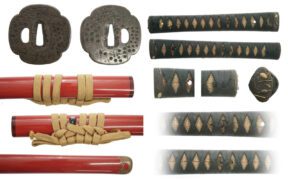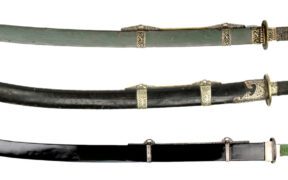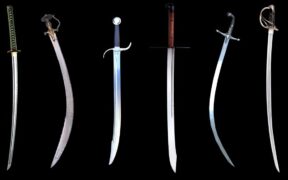Our content features commercial links to our products, committed to transparent, unbiased, and informed editorial recommendations. Learn More
Japanese Sword Parts and Mountings: The Fittings of the Samurai Blade
NO AI USED This Article has been written and edited by our team with no help of the AI
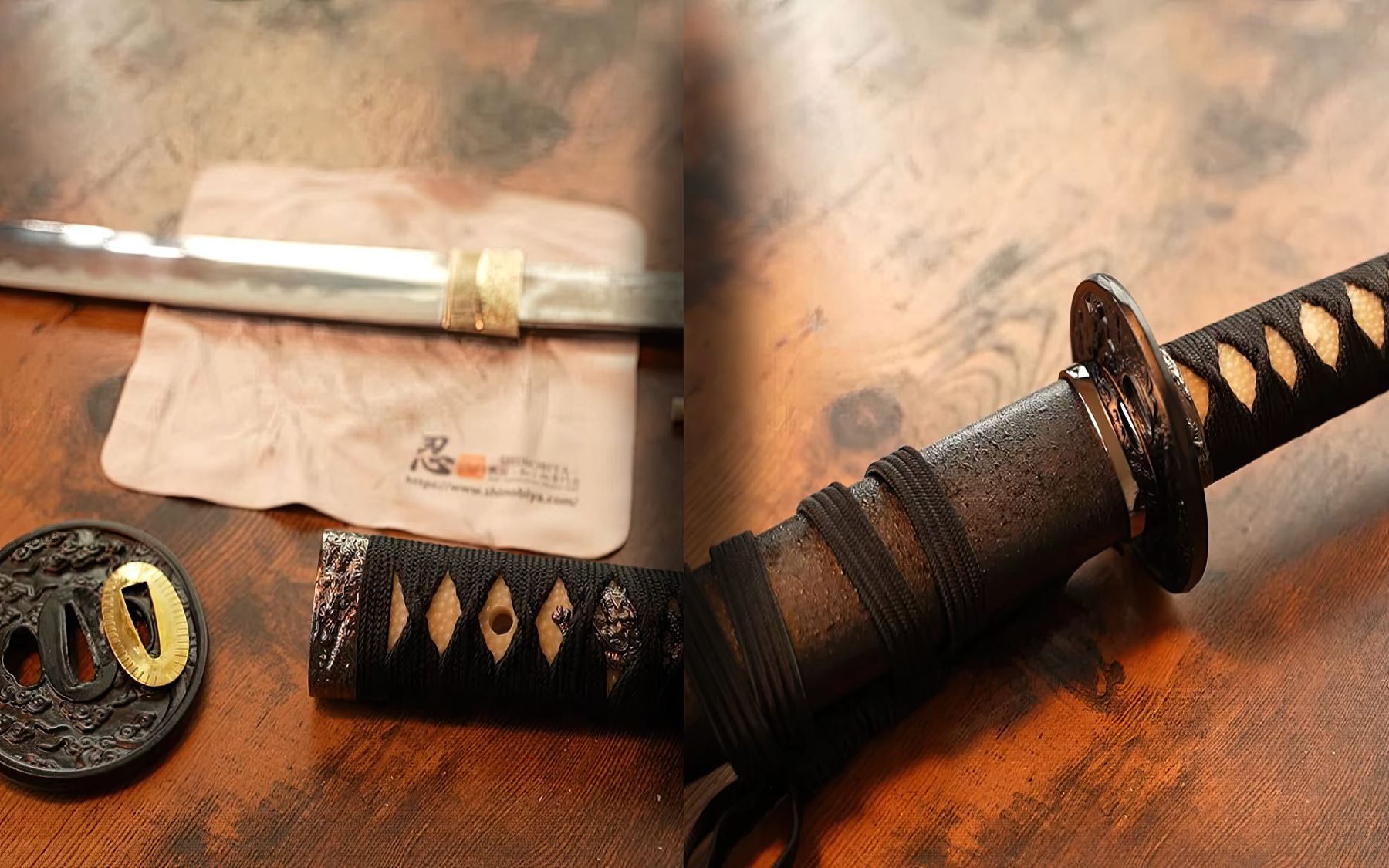
Japanese swords consist of many different parts and mountings, and their popularity lies in the harmonious blend of function and aesthetics. Featuring intricate details, the blade, hilt, and scabbard are all meticulously designed to produce one of the most beautiful and deadliest swords in the world.
In this article, we present the different Japanese sword parts, construction methods, mountings, as well as their functions.
Are All Japanese Swords the Same?
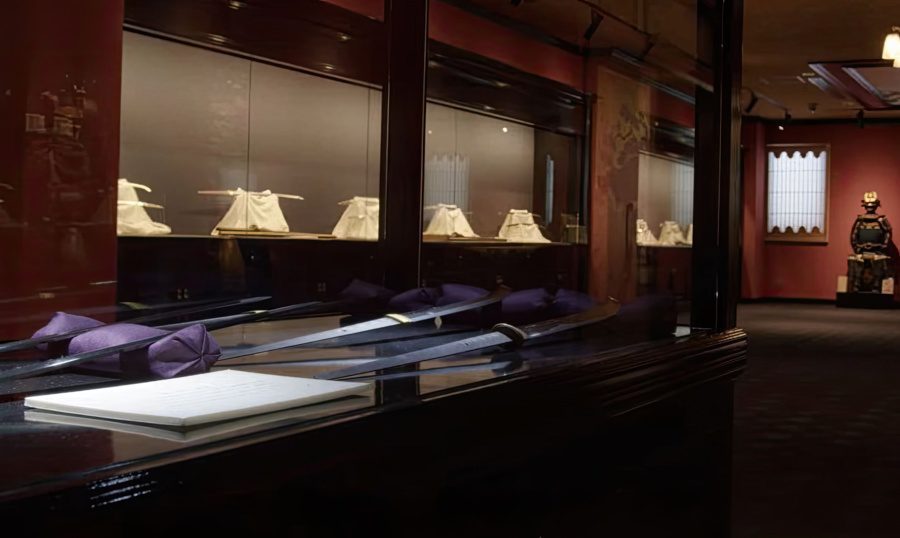
Not all Japanese swords are the same. In fact, they each have different functions due to their different lengths and design patterns. Despite that, they feature very similar sword parts, mountings, and fittings. Here is a list of popular Japanese swords and how they differ from each other in looks and function.
- Katana – The most popular Japanese Sword used and favored by the samurai, it measures 39-inch (1-meter) in length, allowing it to be used as a two-handed weapon in almost any situation.
- Wakizashi – The Wakizashi is often carried together with the katana, making it part of the Daisho set. A smaller version of the Katana in terms of appearance, it can be used as a one-handed secondary weapon.
- Tanto – Also featuring a curved blade, this dagger or knife of the samurai is much smaller in size. It is often favored for its aesthetics which calls for delicate craftsmanship and attention to detail.
- Ninjato – A straight, single-edged bladed weapon, the ninjato is the modern invention or a historical weapon of the ninja, similar in size to a Katana or a Wakizashi. It is also one of the most popular blades to use in a LARP (live-action role-playing) event.
- Tachi – One of the earliest popular samurai blades was the Tachi, a sword different from the rest due to its handle and stronger curvature on the single-edged blade. It can be slightly shorter or as long as the Katana.
- Nodachi – One of the largest Japanese Swords, the Nodachi can measure up to 80 inches (200 cm). These situational “great swords” were used to take down enemy cavalry or split through enemy armor.
Regardless of its size, crafting a Japanese Sword is a meticulous process that can span months or even years. These weapons feature numerous intricate fittings and mountings known as Koshirae. Amounting to approximately 30 components, these elements vary slightly based on the sword type.
Japanese Blade Parts – Nagasa
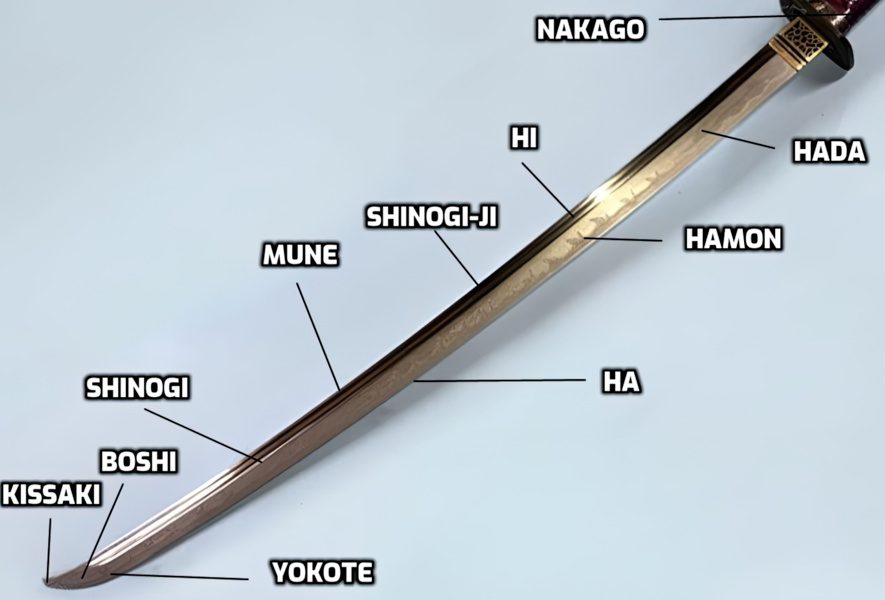
The blade length of a Japanese sword is known as Nagasa. Although Japanese blades are traditionally created by folding Tamahagane steel, various types of steel are used today for crafting them, including stainless steel for decoration and carbon, spring, and tool steel for practical use.
While they can vary in length, most Japanese swords are single-edged. Certain blades, such as the Katana, Wakizashi, and Tanto, have a specific curvature. The earlier Tachi and Nodachi have a stronger curve, while others, like the Ninjato blade, are straight. The curvature of the Japanese sword is referred to as Sori.
- Kissaki
- Boshi
- Yokote
- Nakago
- Hamon
- Bohi
- Mune
- Ha
- Jihada
- Shinogi
- Shinogi-Ji
Kissaki
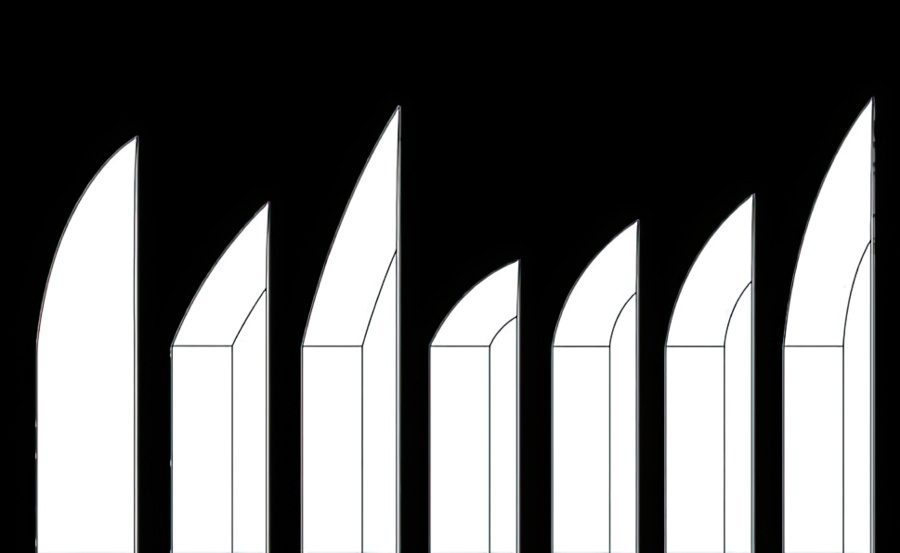
The sharp tip of the Katana is called the Kissaki. This extends from the tip of the blade to the Yokote (line of separation between the tip and the rest of the blade). The degree of curvature is referred to as Fukura.
The kissaki can come in a variety of shapes such as O-Kissaki, Ko-Kissaki, Chu-Kissaki, and even different curvature designs such as Fukura-Kareru and Fukura-Tsuku.
Boshi
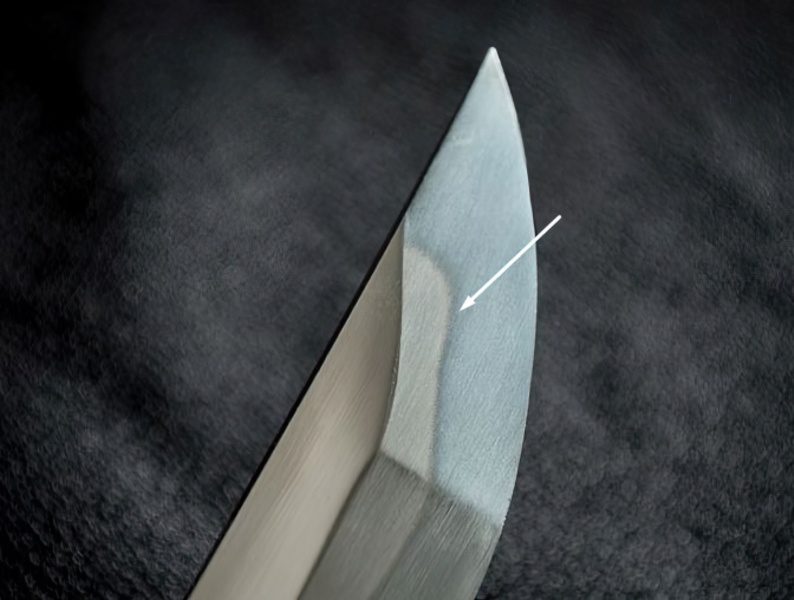
The term “hamon” refers to the visible blade pattern along the length of the blade. However, note that the term “boshi” also refers to the visible blade pattern, but only at the kissaki. Besides for aesthetic purposes, this results in a hardened blade tip effective for powerful cuts and thrusts.
Yokote
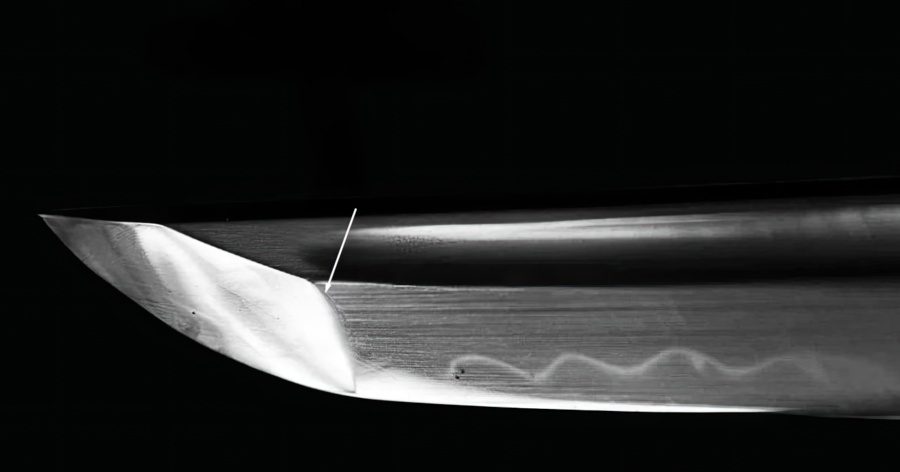
The Yokote is the line that is formed during the forging of the Katana and it is the point where the curve toward the Kissaki starts. Its purpose is to make the tip stronger and more effective when piercing armor as it lessens the impact when thrusting and absorbs the shock so that the blade tip won’t break as easily. Not all Japanese swords feature a Yokote.
Nakago & Mei
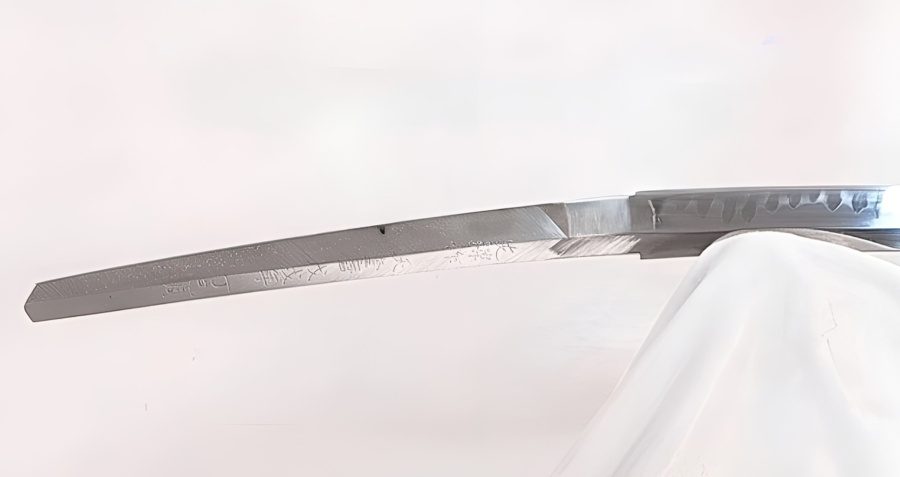
Traditional Japanese swords have full tang blades that extend fully through the handle and end with the pommel. This unsharpened part, which is no longer visible once the sword is mounted, is called the Nakago. The full tang is typically as long as the handle and has one or two holes, known as Mekugi-Ana.
The signature of the swordsmith who created the sword (Mei), is located between these holes or in the center of the Nakago. Different styles of Nakago exist, including Ubu and Suriage, the latter being the shorter one. Additionally, there are Thin-End Nakago, Kimono Sleeved, Tanago, Yagen Nakago, and others.
Ha-Machi & Mune-Machi
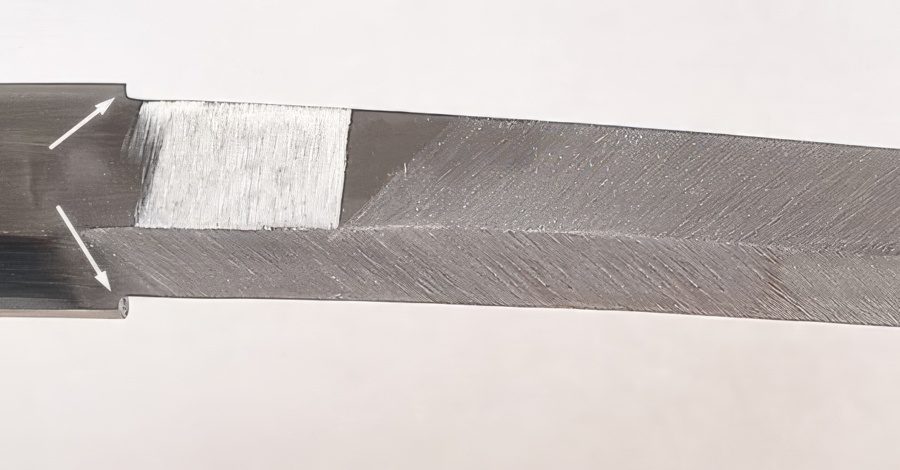
The Nakago ends with the broadening of the blade called Ha-Machi, the one at the blade’s edge, and Mune-Machi, the part at the unsharpened part of the blade or its spine. The Nagasa, or blade length, actually starts from here and ends at the tip called Kissaki.
The Nakago ends with the broadening of the blade’s edge (Ha-Machi) at the blade’s edge and at the unsharpened part of the blade or its spine (Mune-Machi). The blade length (nagasa) starts from this point and ends at the tip (Kissaki).
Hamon
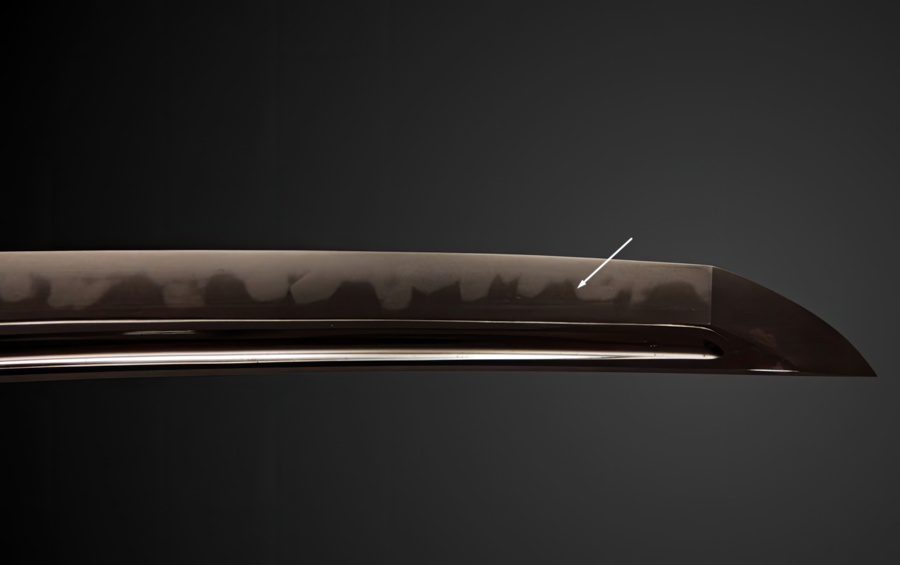
Traditional Japanese swords such as the Katana go through differential clay tempering to harden and sharpen the edge while maintaining core flexibility. This generates a distinct and unique blade pattern known as the Hamon. Besides the common wave shapes, other hamon patterns can include straight, box-shaped, irregular Choji, zig-zag lines, cloudy, crystal forms, etc.
Hi
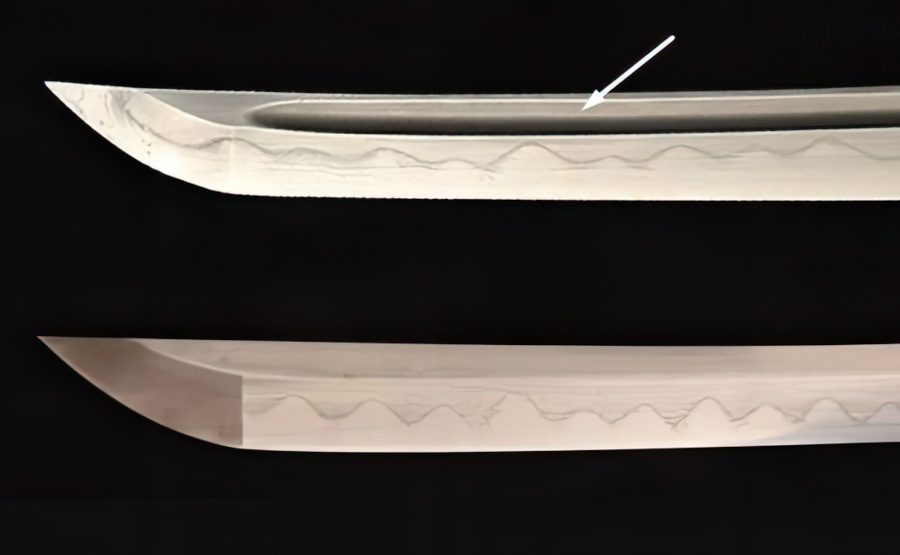
Hi, or at times called Bo-Hi, is the groove or fuller on Japanese blades. Although untrue, It is usually called a blood groove because it is commonly believed to aid in the collection of blood from the slain enemy. Instead, the groove has an aesthetic purpose and helps to decrease the weight of the sword.
There are several types of Hi. Some of the most popular ones are Bo-Hi, Soe-Hi, Koshu-Hi, Shobu-Hi, Naginata-Hi, Kakinagashi-Hi, Tome-Hi, etc.
Mune
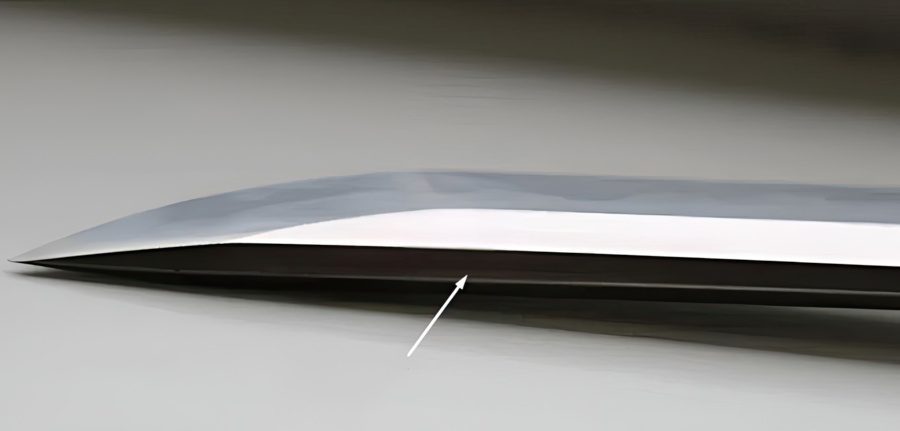
The unsharpened spine of the blade or back of the blade is called Mune. This is the wider part of the Japanese blade and is often made to be flexible to absorb impact and reduce the likelihood of the blade breaking when in use. There are different kinds of Japanese Mune. Some of the most popular ones are Iori-Mune, Hira-Mune, Maru-Mune, and Mitsu-Mune.
Ha
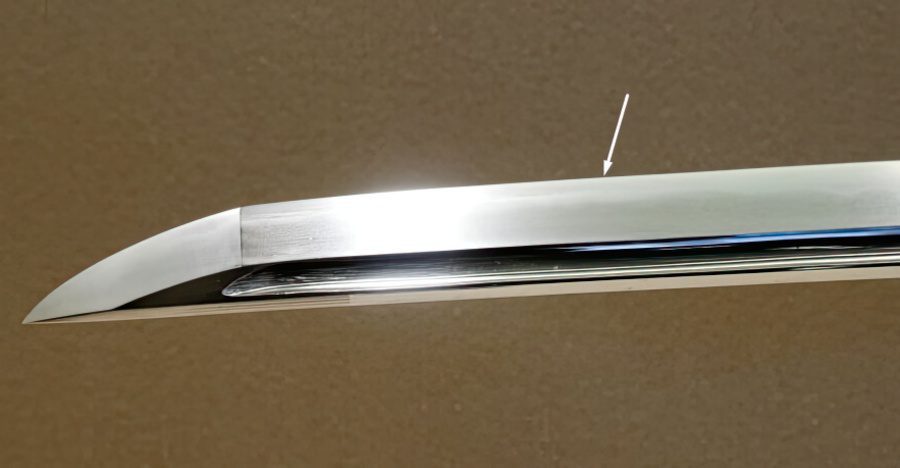
On the opposite side of the Mune lies the actual cutting edge of the Japanese Sword, called the Ha or Hasaki. It is one of the most distinctive parts of a Japanese Katana, and crafting, sharpening, and polishing it requires dedication and years of experience.
Traditionally, the Ha is clay-tempered to make it stronger and stay sharp. Sometimes referred to as Yaiba or Hasaki, it is the part of the sword that is most prone to damage during cutting practice. Therefore, regular maintenance is crucial for these swords.
Jihada
The grain pattern (Jihada) on traditional Japanese swords is a result of folding Tamahagane steel and striking the blade with a mallet, a technique called “tanren”. Sometimes, these are referred to as weld lines and can come in a variety of different forms.
Some of the most popular are Mokume, Masame, Itame, Matsukawa, Ayasugi, Konuka, Nashiji, etc. They can look like wood grains, pine tree bark, or appear to be dotted, straight, irregular, and so on.
Shinogi
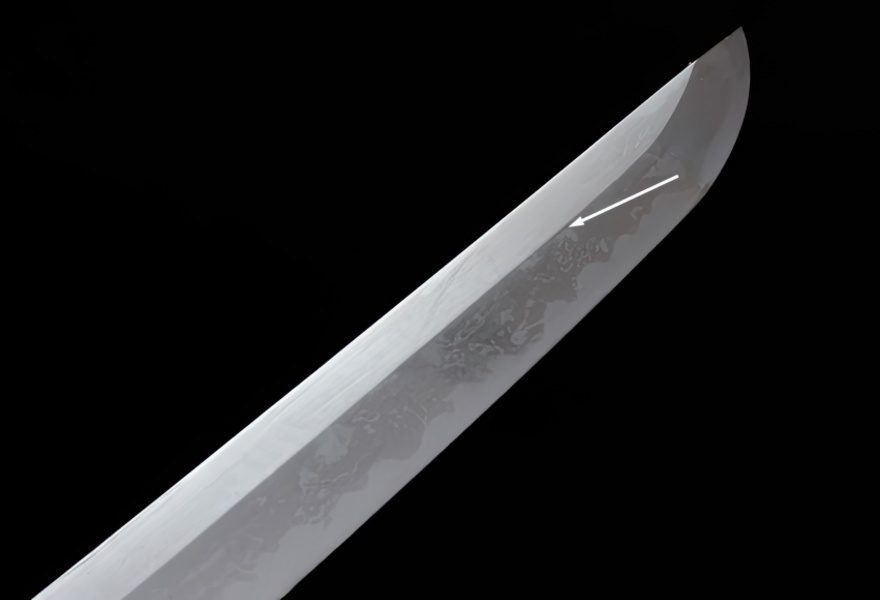
The most prominent part of the Nagasa is the Shinogi, which is the middle ridge line spanning across the blade from the Yokote to the Nakago. The Shinogi can be either near the blade’s edge or closer to the guard. This ridge increases the blade’s strength-to-weight ratio and is a popular feature on a Katana sword.
Some Japanese blades do not feature the Shinogi. A sword that has a Shinogi is called Shinogi-Zukuri, while one that doesn’t is called Hira-Zukuri. This creates two different blade groups.
Shinogi-Ji
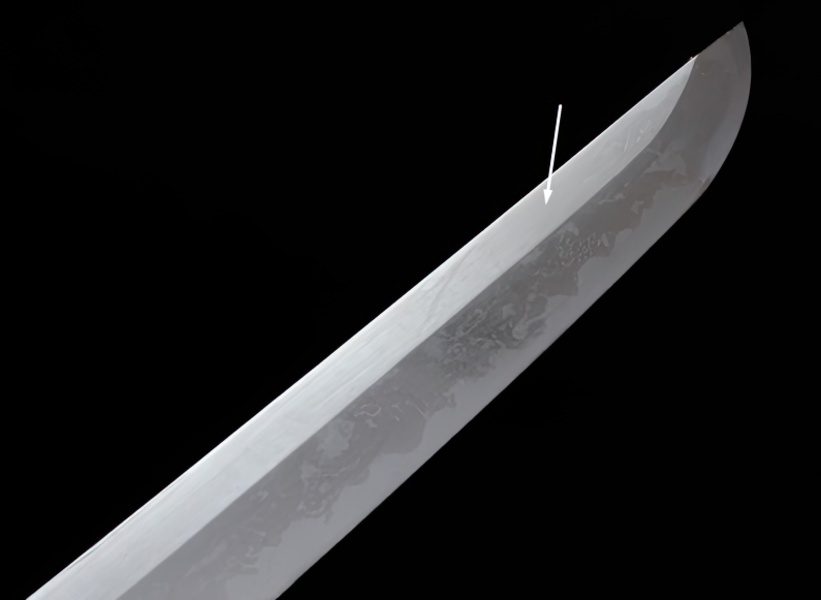
The region between the central bevel Shinogi line and the spine of the Japanese sword is known as the Shinogi-Ji. Typically, this region and line terminate just before the blade’s tip or at the central point called Mitsu-Kado, where the Yokote and Shinogi lines intersect.
Japanese Handle Parts – Tsuka & Tsuba
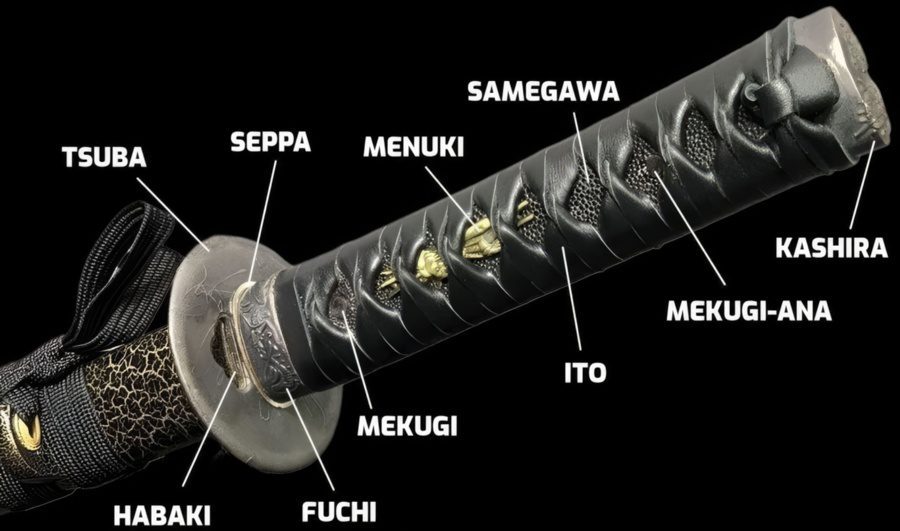
The handle or hilt of the Japanese sword is called a Tsuka. Depending on the size and type of Japanese sword, its handle can be suitable for one or two handed use. It is usually made out of wood wand wrapped in an Ito which follows the traditional pattern called Tsuka-Maki.
It is known as one of the most comfortable sword handles, thanks to the various fittings that are all interlinked, giving it a good grip, rigidity, and strength.
- Tsuba
- Ito
- Samegawa
- Seppa
- Mekugi
- Mekugi-Ana
- Menuki
- Kashira
- Habaki
- Fuchi
Tsuba
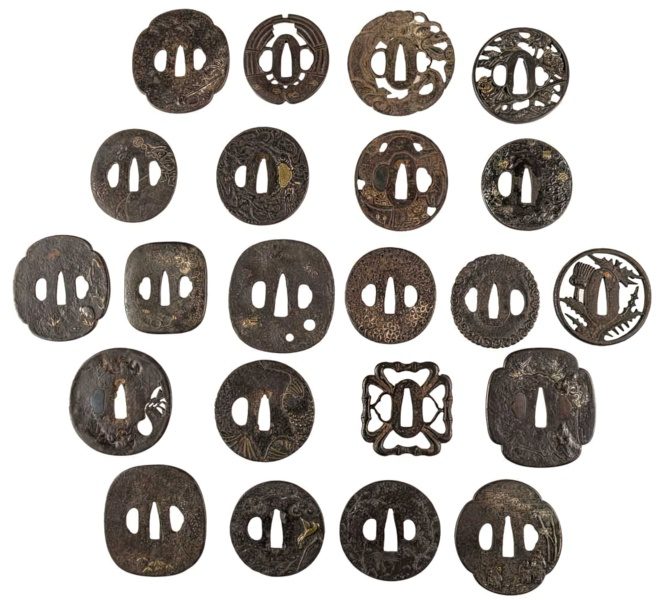
The guard of the Japanese sword (Tsuba) is placed above the handle (Tsuka). Traditional tsubas are usually round, but there are some that are somewhat square. Made out of metal such as iron, brass, steel, copper, or shakudo, they were initially created to protect the wielder’s hands when thrusting into a target.
They can come in many different shapes and sizes such as Maru-Gata, Mokko-Gata, Kiku-Gata, Juji-Gata, etc. Initially, these guards were heavier and made from stronger metal as it served as protection for the samurai. However, during the peaceful Edo period, many decorative elements were added.
One of the earliest produced parts of the Japanese Sword, there are many different parts to a tsuba.
- Nakago–Ana – The opening in the center
- Sekigane – The fillers where the spine and the edge of the blade go through
- Mei – The signature of the swordsmith near the opening
- Mimi – The rim around the Tsuba
- Hira – The surface of the Tsuba guard
- Hitsu–Ana – Other smaller openings near the central one
Ito
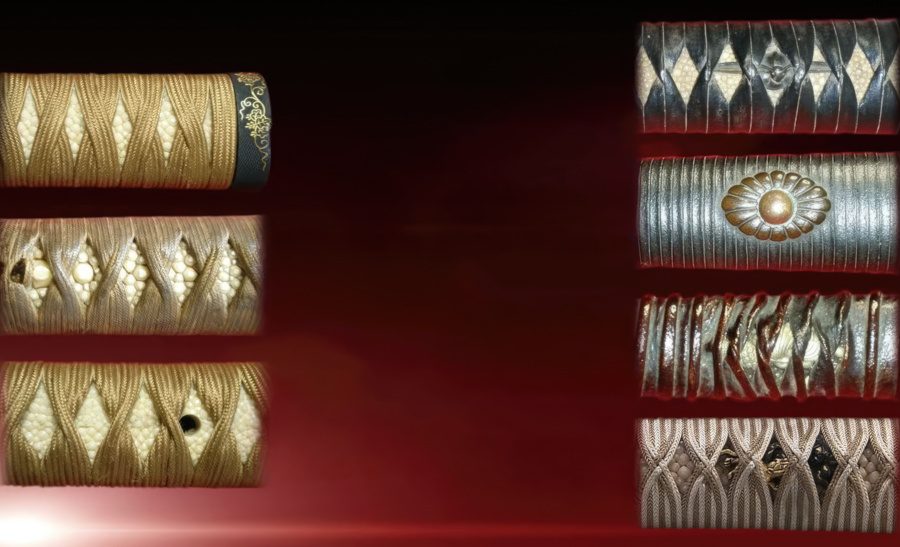
The wrap that goes all around the handle of the Japanese sword is called Tsuka-Ito, or often just called Ito. Although traditionally made out of silk, leather or cotton can also be used. The art of wrapping an Ito around the Tsuka is called Tsuka-Maki. There are different variations of it such as Shino-Maki, Katate-Maki, Ganki-Maki, Kata-Hineri-Maki, Tsunami-Maki, etc.
This wrapping style offers a firm grip when those who wield the samurai swords. The uneven surface allows for a strong grip that is unlikely to slip even if the hands get sweaty. It is also aesthetically pleasing and holds all the other Tsuka parts together.
Samegawa
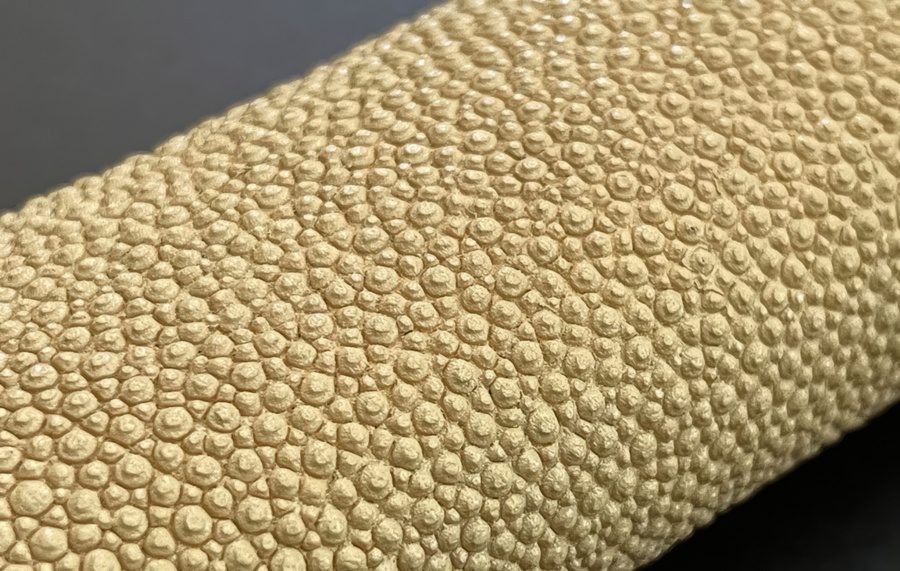
Samegawa or Same-Kawa translating to “shark skin”, is ray skin that is wrapped or added on both sides of the wooden handle to hold the blade’s tang inside. Not only is it beautiful, it is also practical, thanks to its rough surface that offers a non-slip grip.
On most Japanese Swords, the Samegawa can only be seen through the Ito. On smaller blades such as the Tanto, the rayskin wrap is wrapped all around the handle without a wrap. It can be wrapped all around the handle, or just on the sides visible through the wrap. Available in different colors, the pattern of the Samegawa is called Samehada.
Seppa
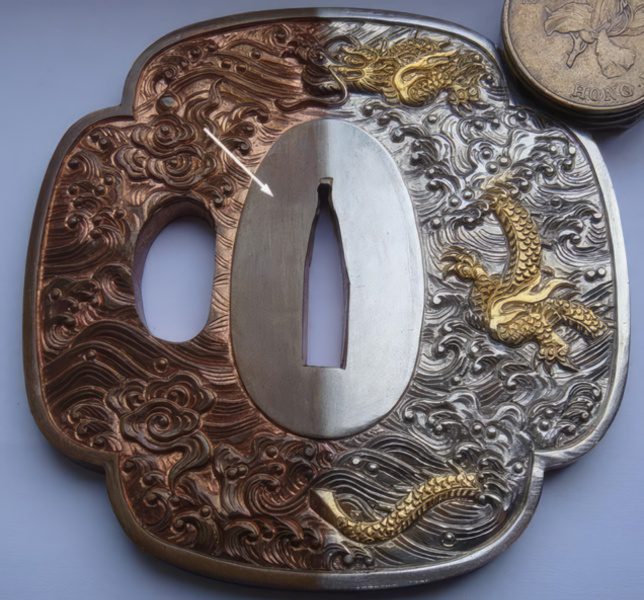
The seppa are two tsuba or hand guard metal fittings that are usually small, round pieces that have an opening in the center for the blade. Placed on both sides of the guard, it is designed to keep the fitting tight, as well as act as spacers between the upper habaki and lower handle parts.
Mekugi
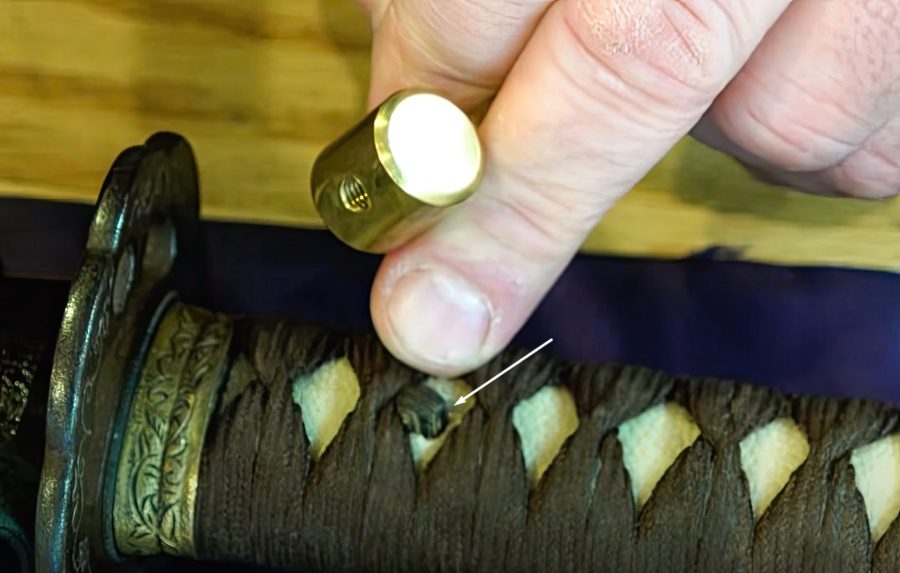
The small peg seen on Japanese sword handles is called mekugi. Depending on the size of the handle or sword, one to two mekugi is added for increased stability. These small pegs are traditionally made out of bamboo, but can be made from wood as well. They function as screws to hold the full-tang blade along with the pommel and handle. It can be taken out using the small hammer found in a traditional maintenance kit for Japanese swords.
Mekugi-Ana
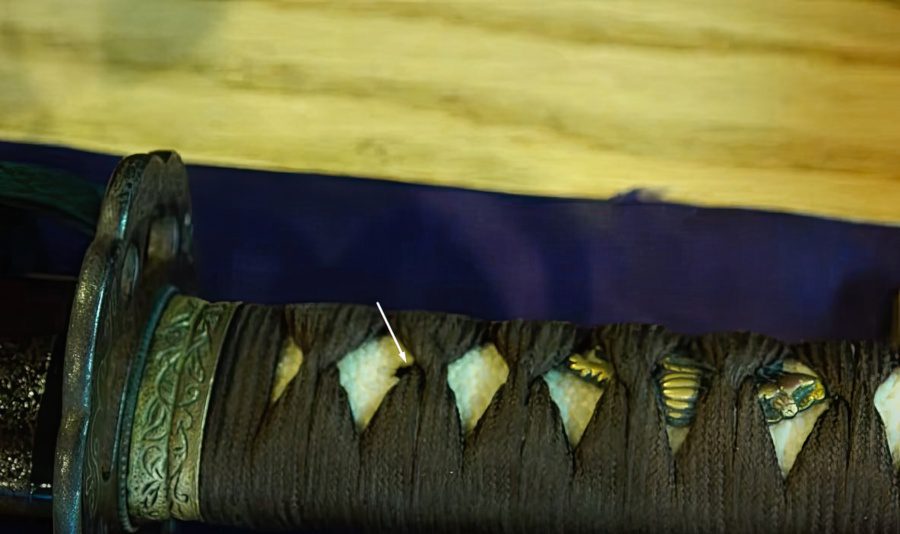
The hole for the mekugi is called mekugi-ana. These holes in the tang allow the insertion of the bamboo or wooden pegs to secure the handle (tsuka) to the tang (nakago).
Menuki
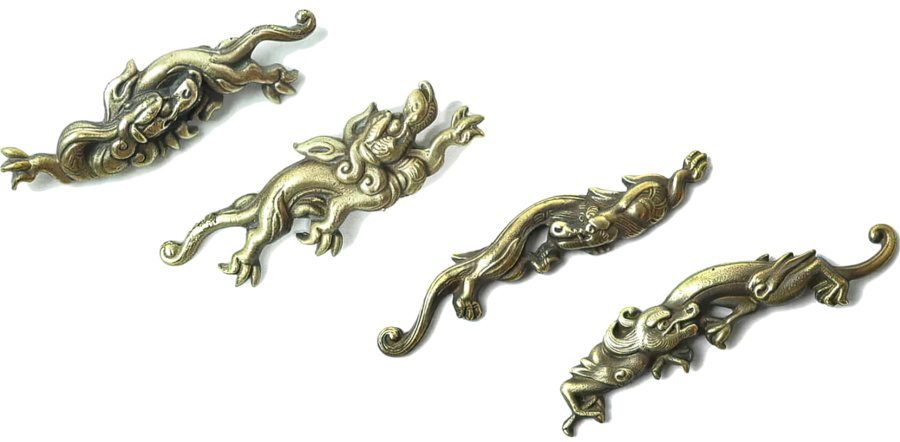
Menuki are metal ornaments or handle charms that are placed on top of the samegawa woven under the tsuka-ito. Most of the time they are placed on top of the Mekugi (pegs) to hide them, but there are some who prefer the pegs to be visible.
These ornaments can be made out of copper, brass, or even iron. On top of serving an aesthetic purpose and adding character to the sword, the Menuki also helps provide the user a stronger grip.
Kashira
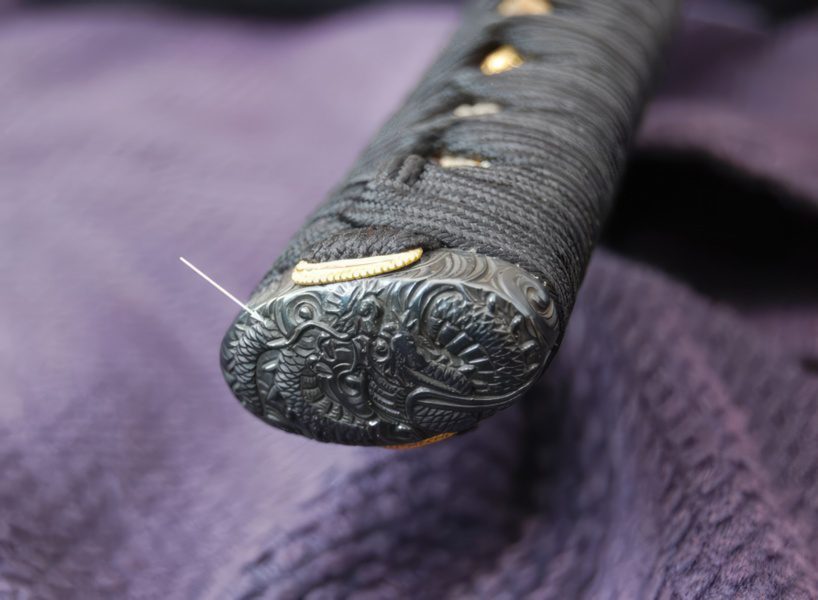
The pommel or pommel cap of the Japanese sword is called a kashira. Generally placed under the handle, the Ito wrap goes through its opening on its sides. The kashira holds the handle of the Japanese sword together and can be made out of iron, brass, or copper. This essential piece usually has the same design as the fuchi (collar).
Habaki
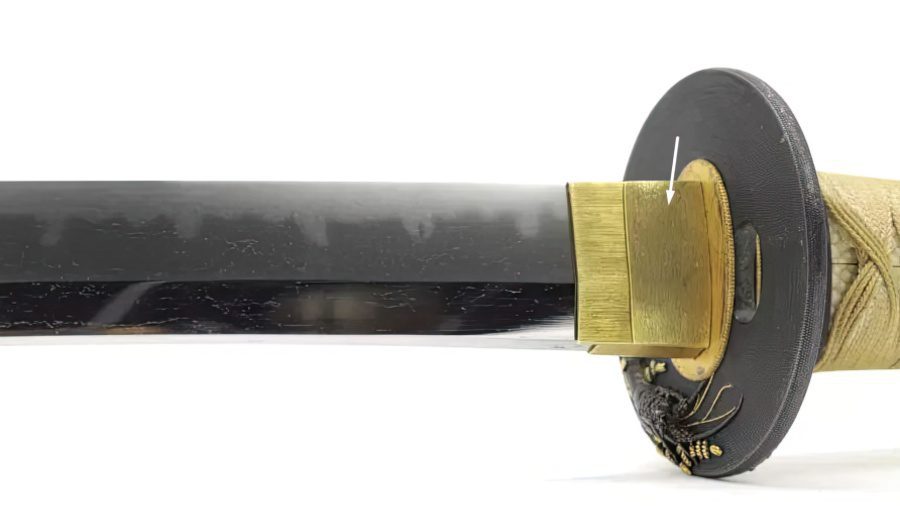
Habaki are metal blade collars, usually wedge-shaped, that are placed above the tsuba to provide more stability to the blade, keep it from falling out of the scabbard, and ensuring the fittings underneath it stay in place. On top of all that, the habaki acts as a ricasso to reduce the impact and vibrations during a blow. For some, they are considered the heart of the Japanese Sword due to their importance.
It is constructed in the same proportions as the koiguchi (scabbard opening) and comes into contact whenever sheathing or unsheathing. That is why the habaki needs to be frequently oiled or at times, replaced with a new one as it is not supposed to be loose.
Fuchi
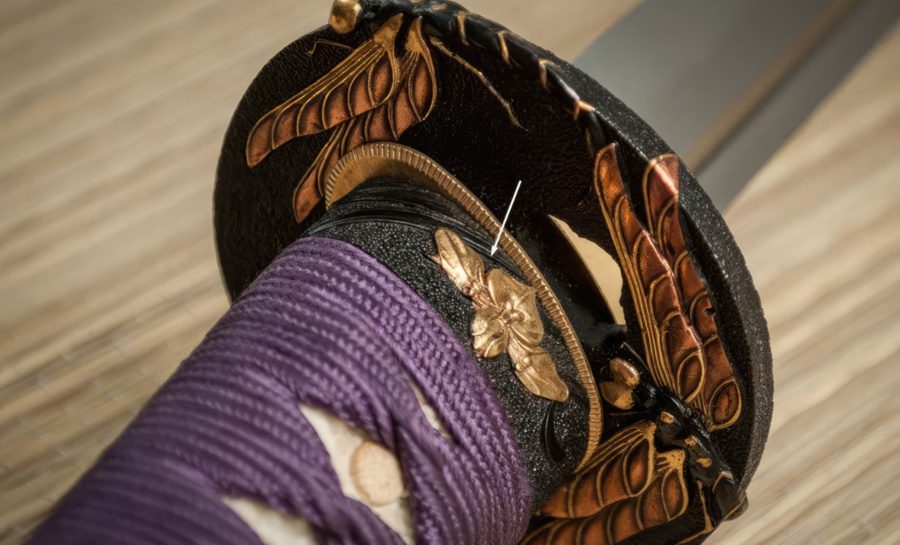
The fuchi is the metal collar or ferrule that is mounted at the base of the grip of a sword hilt. The tang of the blade goes through the Fuchi which is between the handle and guard. Besides adding stability to the handle by reinforcing it, it also has a decorative purpose.
Japanese Scabbard Parts – Saya
The scabbard or sheath of a Japanese sword is called a saya. It is traditionally individually designed for each blade as it needs to fit perfectly so that the sword can be sheathed and unsheathed with ease. It can come in different shapes and sizes depending on the type of Japanese Sword. The shirasaya is a type of simple Japanese scabbard made to store the blade for longer periods of time and does not feature most of the fittings.
It is usually made of wood and has several mountings on it that give it strength and longevity. The creation of a saya is a work of art, as special as creating the blade itself because it is the most visible part of a Japanese Sword when not in use. It can be lacquered or feature ray skin, ribbed sections, and more.
- Koiguchi
- Sageo
- Kurikata
- Shitodome
- Kojiri
- Additions
Koiguchi
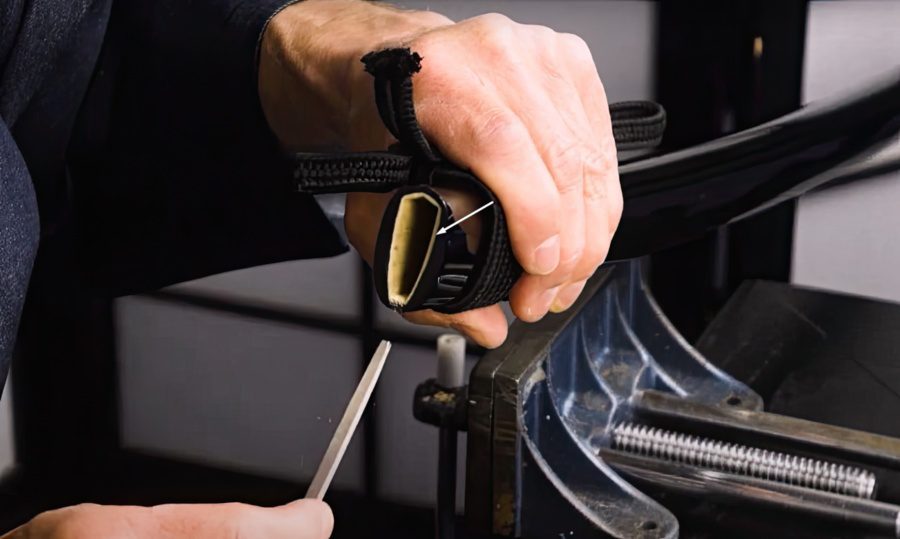
The opening of the scabbard where the blade enters is called Koiguchi. Traditionally, the Koiguchi is made from the horn of a water buffalo, but other materials such as copper, brass, silver, and even gold can be used. As one of the most important parts of the saya, the koiguchi is created with great precision. It functions to prevent the wood from splintering, eases the sheathing process, as well as making it easier and quicker to unsheathe the sword.
The koiguchi needs to correspond with the habaki as they should be aligned when coming into contact once the blade is sheathed. Since the koiguchi is a Japanese sword part that usually gets damaged the most, frequent care and maintenance of it is needed.
Sageo
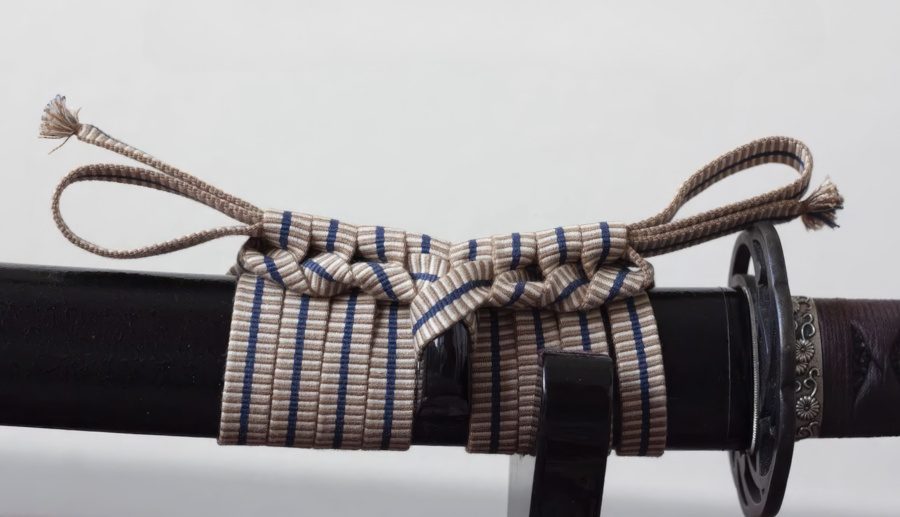
The silk, leather, or cotton cord that is tied to the saya is called the sageo. It is designed for the wielder to hang the sword on a traditional Japanese belt (Obi). There are different styles to tie the sageo including Cho Musubi, Taicho Musubi, Ronin Musubi, Daimyo Musubi, Ronin Musubi, as well as Myoga Musubi for smaller Japanese swords. The sageo is usually tied tightly around the Kurikata.
Kurikata
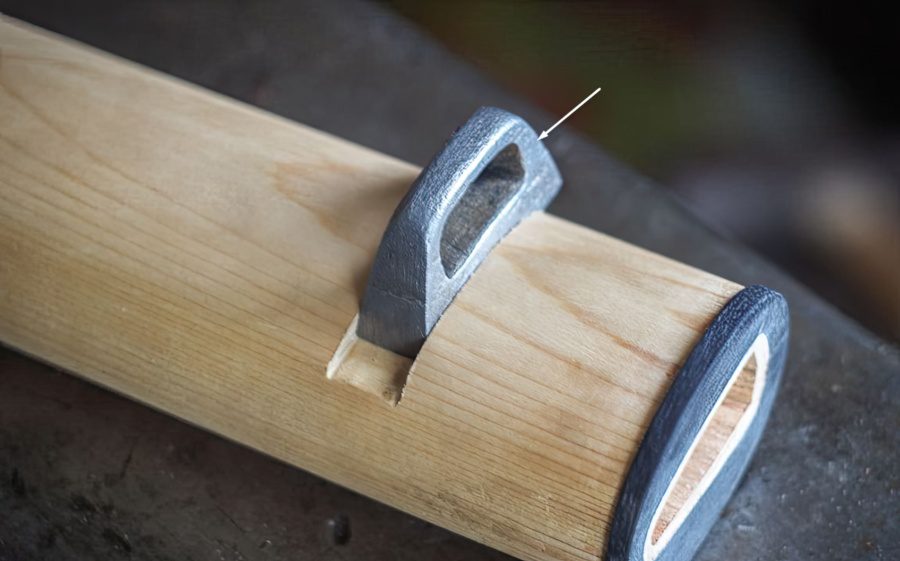
The knob attached to the saya is called the kurikata. This protrusion allows the Sageo wrap to go through it, securing the saya to the obi. It can be made out of wood, steel, and even silver, usually the same material as the scabbard. However, it is traditionally made of a water buffalo’s horn.
Shitodome
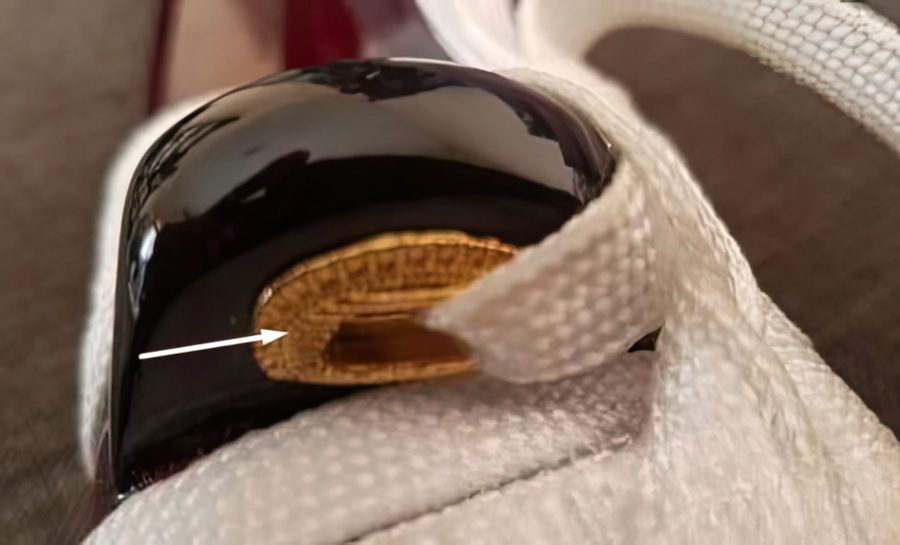
The shitodome is the decorative metal piece that fits inside the kurikata. This small scabbard fitting can be considered as an extension of the kurikata, meaning that they always go together. It is usually made out of metal, gold, or silver.
Kojiri
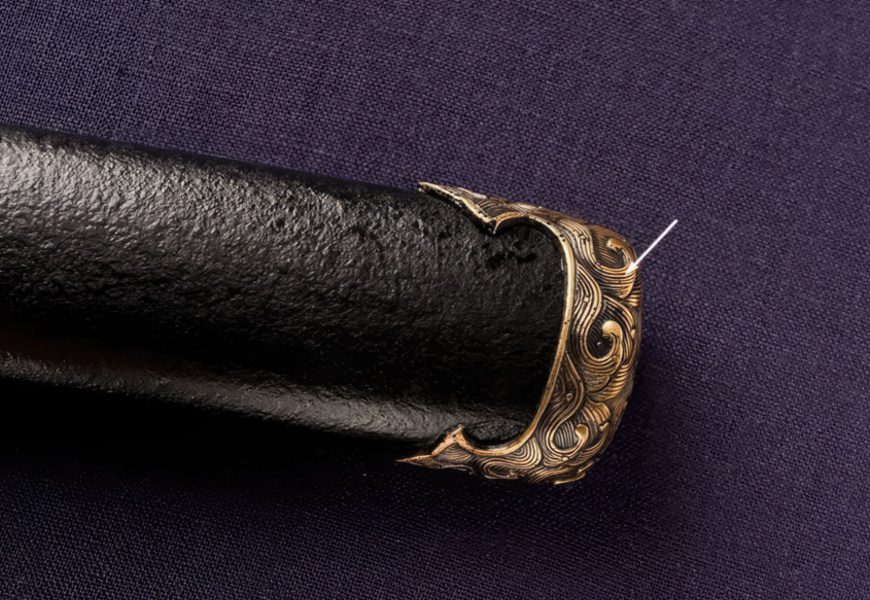
The end cap of the scabbard that houses the top of the sword (kissaki) is called the kojiri. This protective fitting is traditionally made from water buffalo horn, but can also be made of metal too. It provides extra stability and strength to the scabbard, as well as extra protection to the blade while it is sheathed.
Additions
Most likely starting much earlier, but becoming very popular during the peaceful Edo period in Japan, various additions were made to the Japanese scabbards to assist with the samurai way of life. Here are some practical and aesthetic additions that were made.
Kogatana & Kozuka

A kogatana is a very small utility knife used for various activities that might need a small blade. It is sometimes found in a pocket on the side of the scabbard. The term “kozuka” refers to the handle and is the visible part of the Kogatana when it is inside the scabbard’s pocket.
Kogai

The kogai (translating to sword needle) is part of a sword mounting that functions as a hairdressing tool. Carried in a slot on the obverse side of the saya, it can be used as a spike or comb that might help samurais to arrange or hold their hair in a certain way.
Umabari

The smallest knife of all the Japanese swords is called the umabari, a variation of the kogatana and can sometimes have a blade that can function like a screwdriver. This might be helpful in the dismounting of all the different parts of the Katana.
